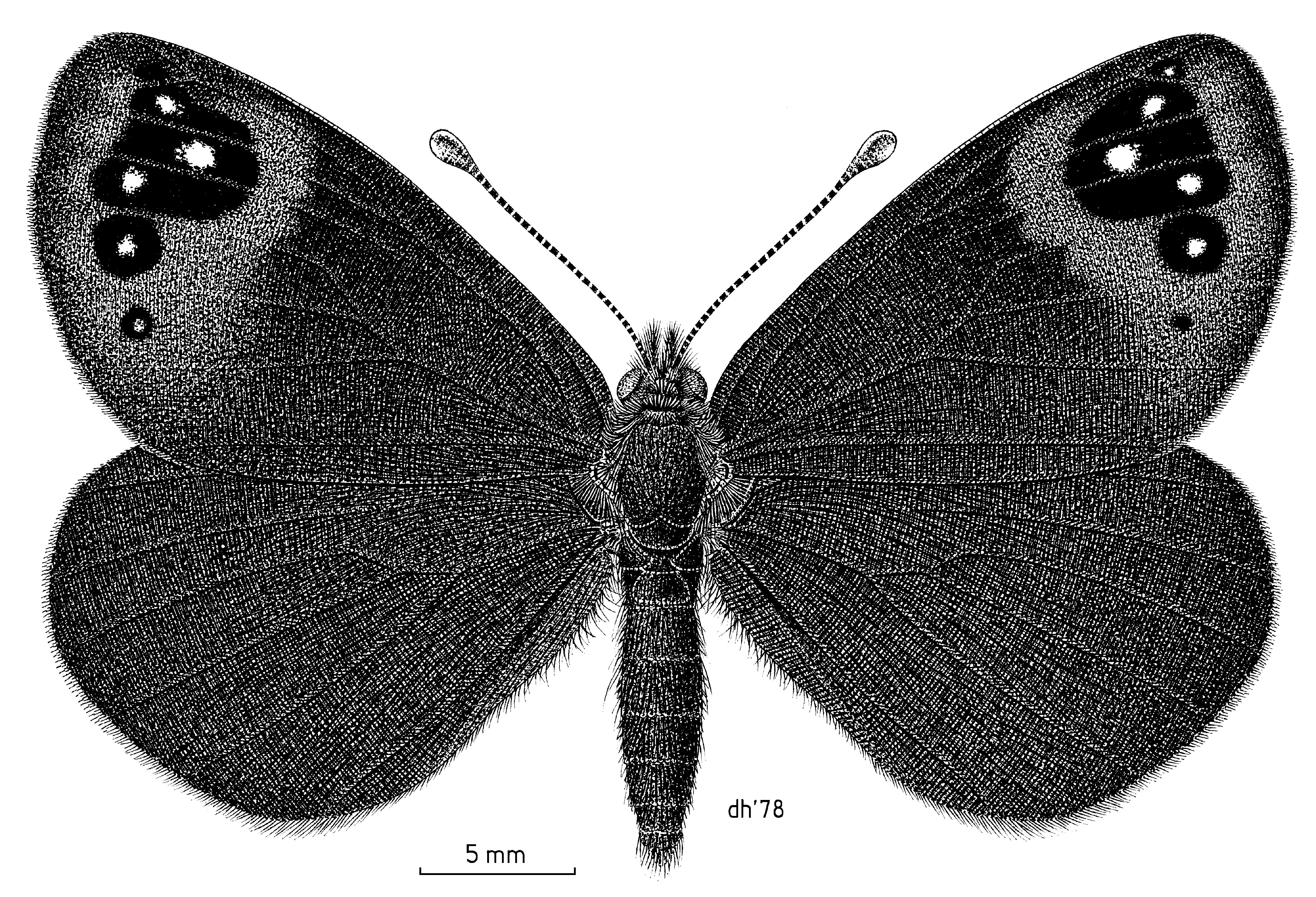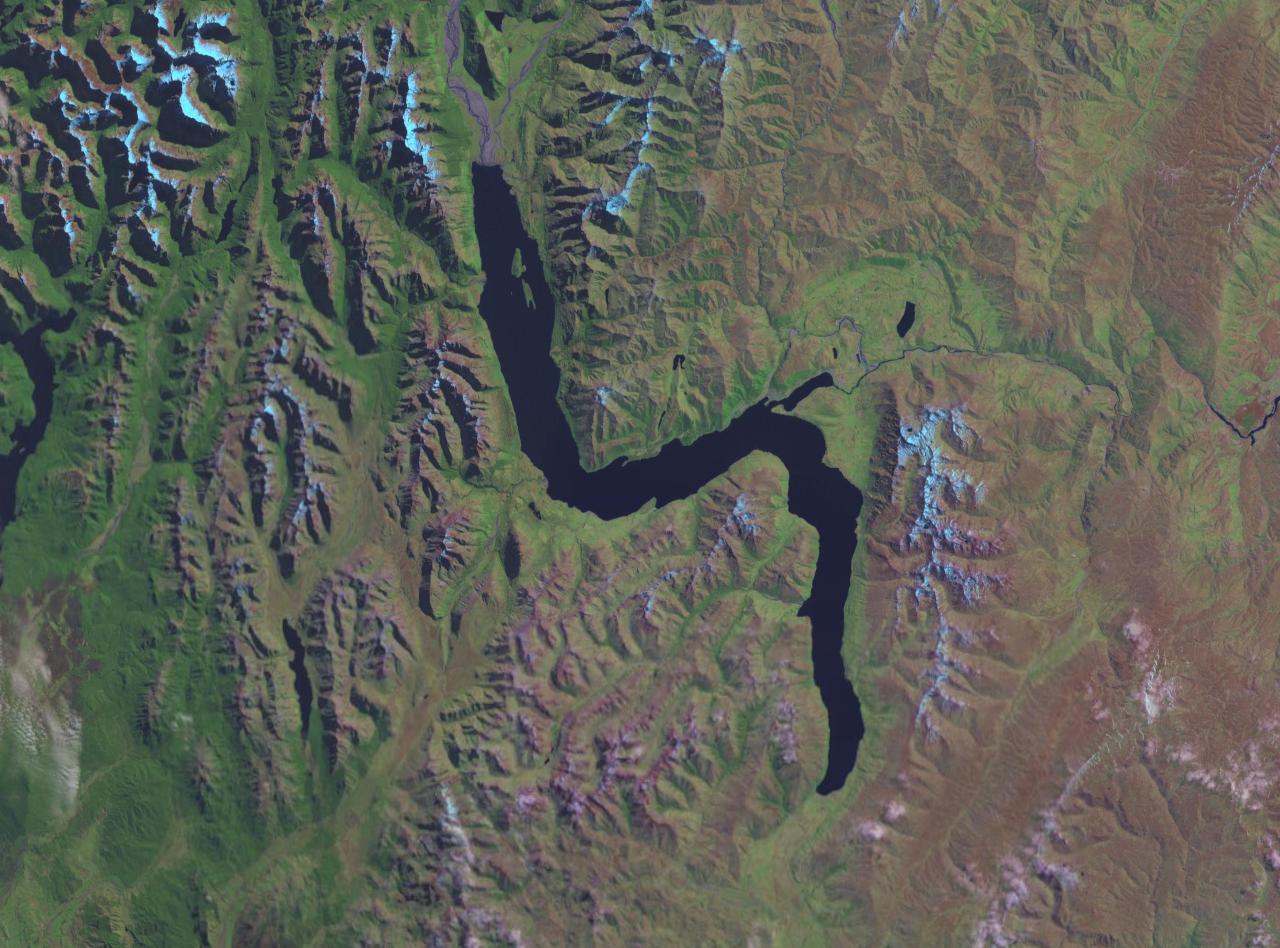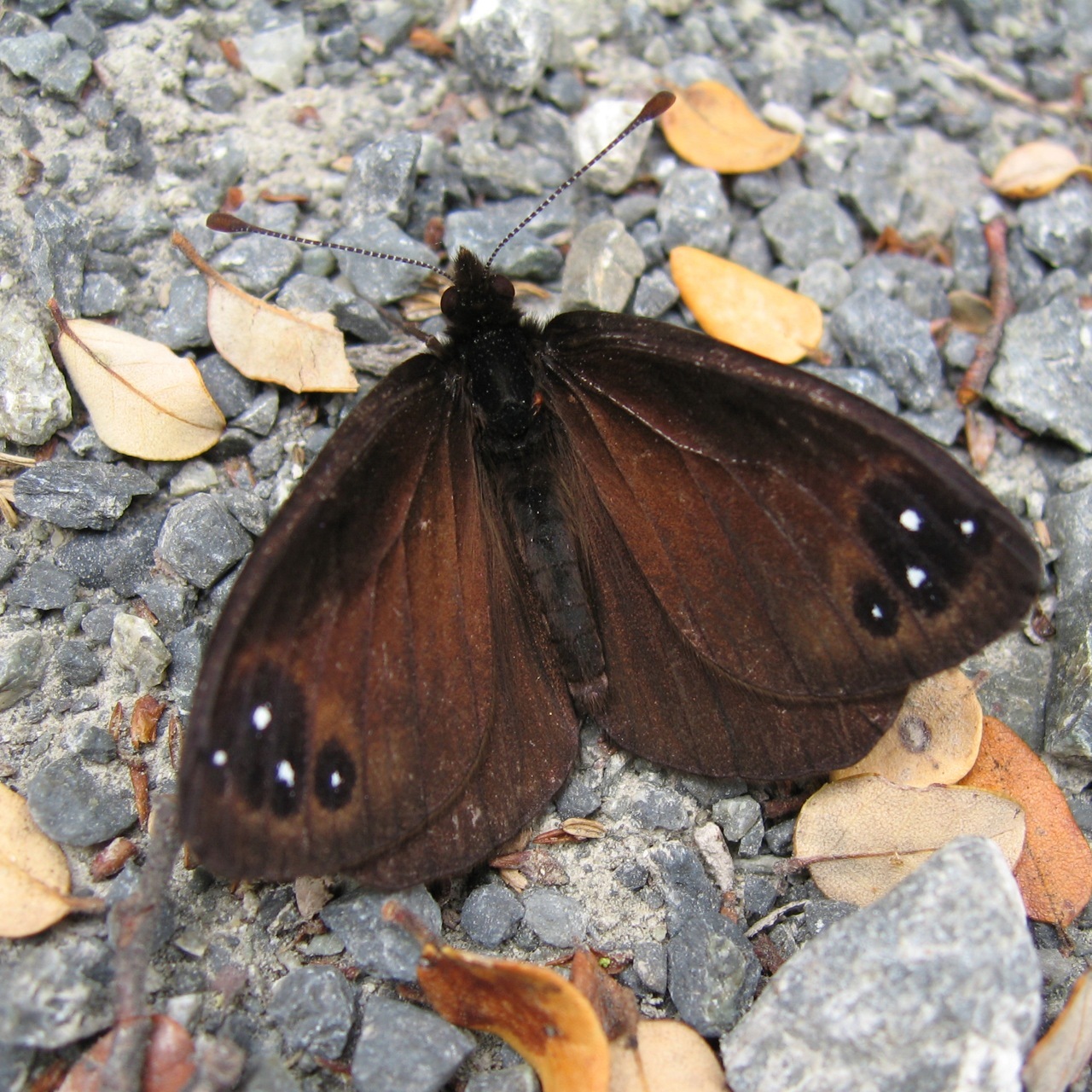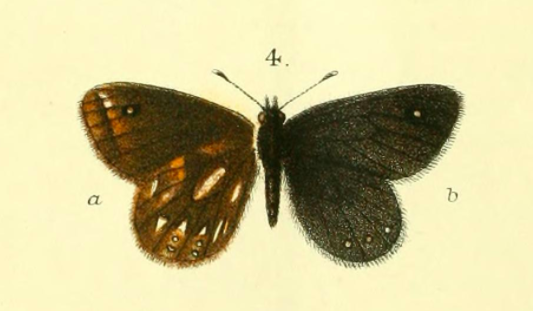|
Percnodaimon Merula
''Percnodaimon merula'', the black mountain ringlet, is a satyrid butterfly in the family Nymphalidae. It is currently the only recognised species in the monotypic genus ''Percnodaimon,'' endemic to New Zealand, although there may be other undescribed species in the genus. The black mountain ringlet is notable for living exclusively in rocky areas of New Zealand's Southern Alps, usually above 1200 m. Its eggs are laid on rocks, its larvae feed on mountain ''Poa'' species, and it pupates under a stone. It has distinctive dark velvety wings and a zig-zag flight pattern over the scree slopes on which it lives. Taxonomy This species has had a complicated taxonomic history. It was originally described as ''Erebia pluto'' by Richard W. Fereday in 1872 from the Craigieburn Range in the South Island, and was moved to the new genus ''Percnodaimon'' by Butler in 1876. It was known as ''Percnodaimon pluto'' for many years, and Wise in 1967 regarded this as the correct name for the spec ... [...More Info...] [...Related Items...] OR: [Wikipedia] [Google] [Baidu] |
Arthur Gardiner Butler
Arthur Gardiner Butler F.L.S., F.Z.S. (27 June 1844 – 28 May 1925) was an English entomologist, arachnologist and ornithologist. He worked at the British Museum on the taxonomy of birds, insects, and spiders. Biography Arthur Gardiner Butler was born at Cheyne Walk, Chelsea, London. He was the son of Thomas Butler (1809–1908), assistant-secretary to the British Museum.Thomas Butler: He was educated at St. Paul's School,He was admitted 15-03-1854, according to: later receiving a year's tuition in drawing at the Art School of South Kensington. At the British Museum, he was appointed as an officer with two roles, as an assistant-keeper in zoology and as an assistant-librarian in 1879. Work He also published articles on spiders of Australia, the Galápagos, Madagascar, and other places. In 1859, he described the Deana moth. Bibliography Entomology *"Monograph of the species of ''Charaxes'', a genus of diurnal Lepidoptera". ''Proceedings of the Zoological Socie ... [...More Info...] [...Related Items...] OR: [Wikipedia] [Google] [Baidu] |
Lake Wakatipu
Lake Wakatipu ( mi, Whakatipu Waimāori) is an inland lake (finger lake) in the South Island of New Zealand. It is in the southwest corner of the Otago region, near its boundary with Southland. ''Lake Wakatipu'' comes from the original Māori name . With a length of , it is New Zealand's longest lake, and, at , its third largest. The lake is also very deep, its floor being below sea level, with a maximum depth of . It is at an altitude of , towards the southern end of the Southern Alps / Kā Tiritiri o te Moana. The general topography is a reversed "N" shape or "dog leg". The Dart River / Te Awa Whakatipu flows into the northern end, the lake then runs south for 30 kilometres before turning abruptly to the east. Twenty kilometres (12.4 mi) further along, it turns sharply to the south, reaching its southern end further south, near Kingston. The lake is drained by the Kawarau River, which flows out from the lake's only arm, the Frankton Arm, east of Queenstown. Until ... [...More Info...] [...Related Items...] OR: [Wikipedia] [Google] [Baidu] |
Percnodaimon Merula 59489853
''Percnodaimon merula'', the black mountain ringlet, is a satyrid butterfly in the family Nymphalidae. It is currently the only recognised species in the monotypic genus ''Percnodaimon,'' endemic to New Zealand, although there may be other undescribed species in the genus. The black mountain ringlet is notable for living exclusively in rocky areas of New Zealand's Southern Alps, usually above 1200 m. Its eggs are laid on rocks, its larvae feed on mountain ''Poa'' species, and it pupates under a stone. It has distinctive dark velvety wings and a zig-zag flight pattern over the scree slopes on which it lives. Taxonomy This species has had a complicated taxonomic history. It was originally described as ''Erebia pluto'' by Richard W. Fereday in 1872 from the Craigieburn Range in the South Island, and was moved to the new genus ''Percnodaimon'' by Butler in 1876. It was known as ''Percnodaimon pluto'' for many years, and Wise in 1967 regarded this as the correct name for the spec ... [...More Info...] [...Related Items...] OR: [Wikipedia] [Google] [Baidu] |
Solar Panels
A solar cell panel, solar electric panel, photo-voltaic (PV) module, PV panel or solar panel is an assembly of photovoltaic solar cells mounted in a (usually rectangular) frame, and a neatly organised collection of PV panels is called a photovoltaic system or solar array. Solar panels capture sunlight as a source of radiant energy, which is converted into electric energy in the form of direct current (DC) electricity. Arrays of a photovoltaic system can be used to generate solar electricity that supplies electrical equipment directly, or feeds power back into an alternate current (AC) grid via an inverter system. History In 1839, the ability of some materials to create an electrical charge from light exposure was first observed by the French physicist Edmond Becquerel. Though these initial solar panels were too inefficient for even simple electric devices, they were used as an instrument to measure light. The observation by Becquerel was not replicated again until 1873 ... [...More Info...] [...Related Items...] OR: [Wikipedia] [Google] [Baidu] |
Percnodaimon Merula 1179344
''Percnodaimon merula'', the black mountain ringlet, is a satyrid butterfly in the family Nymphalidae. It is currently the only recognised species in the monotypic genus ''Percnodaimon,'' endemic to New Zealand, although there may be other undescribed species in the genus. The black mountain ringlet is notable for living exclusively in rocky areas of New Zealand's Southern Alps, usually above 1200 m. Its eggs are laid on rocks, its larvae feed on mountain ''Poa'' species, and it pupates under a stone. It has distinctive dark velvety wings and a zig-zag flight pattern over the scree slopes on which it lives. Taxonomy This species has had a complicated taxonomic history. It was originally described as ''Erebia pluto'' by Richard W. Fereday in 1872 from the Craigieburn Range in the South Island, and was moved to the new genus ''Percnodaimon'' by Butler in 1876. It was known as ''Percnodaimon pluto'' for many years, and Wise in 1967 regarded this as the correct name for the spec ... [...More Info...] [...Related Items...] OR: [Wikipedia] [Google] [Baidu] |
George Hudson (entomologist)
George Vernon Hudson FRSNZ (20 April 1867 – 5 April 1946) was a British-born New Zealand entomologist credited with proposing the modern daylight saving time. He was awarded the Hector Memorial Medal in 1923. Biography Born in London, Britain, on Easter Saturday, 1867 Hudson was the sixth child of Emily Jane Carnal and Charles Hudson, an artist and stained-glass window designer. By the age of 14 he had built up a collection of British insects, and had published a paper in '' The Entomologist''. In 1881 Hudson moved with his father to Nelson, New Zealand. He worked on a farm, and in 1883, aged 16, he began working at the post office in Wellington, where he eventually became chief clerk, retiring in 1918. Hudson was a member of the 1907 Sub-Antarctic Islands Scientific Expedition. Its main aim was to extend the magnetic survey of New Zealand by investigating the Auckland and Campbell islands but botanical, biological, and zoological surveys were also conducted. The expeditio ... [...More Info...] [...Related Items...] OR: [Wikipedia] [Google] [Baidu] |
Thermal
A thermal column (or thermal) is a rising mass of buoyant air, a convective current in the atmosphere, that transfers heat energy vertically. Thermals are created by the uneven heating of Earth's surface from solar radiation, and are an example of convection, specifically atmospheric convection. Thermals on Earth The Sun warms the ground, which in turn warms the air directly above. The warm air near the surface expands, becoming less dense than the surrounding air. The lighter air rises and cools due to its expansion in the lower pressure at higher altitudes. It stops rising when it has cooled to the same temperature, thus density, as the surrounding air. Associated with a thermal is a downward flow surrounding the thermal column. The downward-moving exterior is caused by colder air being displaced at the top of the thermal. The size and strength of thermals are influenced by the properties of the lower atmosphere (the ''troposphere''). When the air is cold, bubbles of warm ... [...More Info...] [...Related Items...] OR: [Wikipedia] [Google] [Baidu] |
Imago
In biology, the imago (Latin for "image") is the last stage an insect attains during its metamorphosis, its process of growth and development; it is also called the imaginal stage, the stage in which the insect attains maturity. It follows the final ecdysis of the immature instars.Carpenter, Geo. H., The Life-Story of Insects. Cambridge University Press 1913. May be downloaded from: https://www.gutenberg.org/ebooks/16410 or https://archive.org/details/thelifestoryofin16410gut In a member of the Ametabola or Hemimetabola, in which metamorphosis is "incomplete", the final ecdysis follows the last immature or '' nymphal'' stage. In members of the Holometabola, in which there is a pupal stage, the final ecdysis follows emergence from the pupa, after which the metamorphosis is complete, although there is a prolonged period of maturation in some species. The imago is the only stage during which the insect is sexually mature and, if it is a winged species, has functional wings. The i ... [...More Info...] [...Related Items...] OR: [Wikipedia] [Google] [Baidu] |
Erebiola Butleri
''Erebiola butleri'', or Butler's ringlet, is an elusive New Zealand endemic butterfly, discovered in 1879 by John Enys at the alpine pass at the head of the Rakaia River. It is the only member of the genus ''Erebiola''. ''Erebiola'' is derived from Erebus, the ancient Greek world of darkness between Earth and Hades, while the specific name, ''butleri'', was after Arthur Gardiner Butler of the British Museum who played a major role in early descriptions of New Zealand butterflies. Its Māori name is ''pepe pouri'', which means dark moth, and shares the name with the black mountain ringlet and the forest ringlet butterfly. Description Butler's ringlet has a wingspan of 35–43 mm, with a 40 mm average for males and a 37 mm average for females. Both males and females are smoky brown, though males tend towards the richer browns while the females tend towards the paler browns. The underside of the hindwing has wedge-shaped silvery-white marks. Both the under ... [...More Info...] [...Related Items...] OR: [Wikipedia] [Google] [Baidu] |
Dodonidia Helmsii
The forest ringlet (''Dodonidia helmsii''), also known as Helms' butterfly, is a rare butterfly of the family Nymphalidae endemic to New Zealand. It is the only species in the genus ''Dodonidia''. Taxonomy The forest ringlet was first described by Richard William Fereday from a specimen collected in the Paparoa Range by a Mr R. Helms of Greymouth. Fereday gave it the specific name ''helmsi'', but would not speculate as to its genus. The species was properly named in 1884 by Arthur Gardiner Butler, who coined the genus ''Dodonidia'', from its resemblance to the Asian ''Dodona'' butterflies, and corrected the spelling of the species name to ''D. Helmsii'' (now ''D. helmsii''). Because it was named after Helms, it is properly known as "Helms' butterfly", although this is often misspelled as "Helm's butterfly". The name "forest ringlet" is more commonly used. Ecology The forest ringlet caterpillar is nocturnal and feeds on "cutty grass" (''Gahnia'') and bush snowgrass (''Chi ... [...More Info...] [...Related Items...] OR: [Wikipedia] [Google] [Baidu] |
Māori Language
Māori (), or ('the Māori language'), also known as ('the language'), is an Eastern Polynesian language spoken by the Māori people, the indigenous population of mainland New Zealand. Closely related to Cook Islands Māori, Tuamotuan, and Tahitian, it gained recognition as one of New Zealand's official languages in 1987. The number of speakers of the language has declined sharply since 1945, but a Māori-language revitalisation effort has slowed the decline. The 2018 New Zealand census reported that about 186,000 people, or 4.0% of the New Zealand population, could hold a conversation in Māori about everyday things. , 55% of Māori adults reported some knowledge of the language; of these, 64% use Māori at home and around 50,000 people can speak the language "very well" or "well". The Māori language did not have an indigenous writing system. Missionaries arriving from about 1814, such as Thomas Kendall, learned to speak Māori, and introduced the Latin alphabet. In 1 ... [...More Info...] [...Related Items...] OR: [Wikipedia] [Google] [Baidu] |








